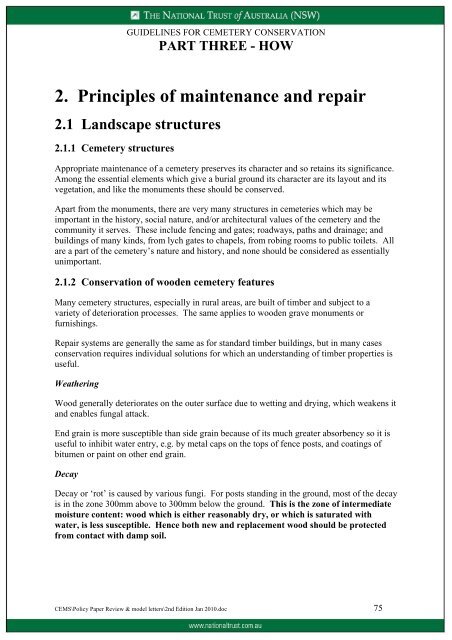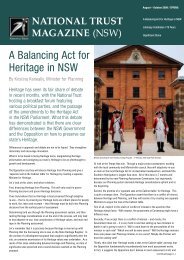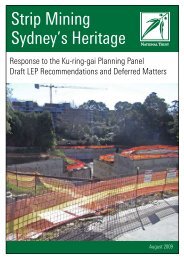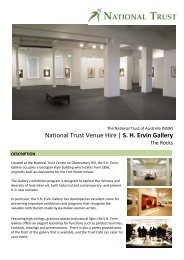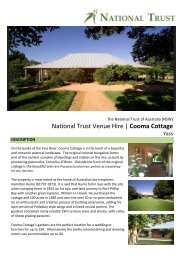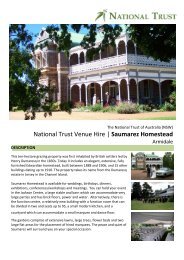Guidelines for Cemetery Conservation - National Trust of Australia
Guidelines for Cemetery Conservation - National Trust of Australia
Guidelines for Cemetery Conservation - National Trust of Australia
Create successful ePaper yourself
Turn your PDF publications into a flip-book with our unique Google optimized e-Paper software.
GUIDELINES FOR CEMETERY CONSERVATION<br />
PART THREE - HOW<br />
2. Principles <strong>of</strong> maintenance and repair<br />
2.1 Landscape structures<br />
2.1.1 <strong>Cemetery</strong> structures<br />
Appropriate maintenance <strong>of</strong> a cemetery preserves its character and so retains its significance.<br />
Among the essential elements which give a burial ground its character are its layout and its<br />
vegetation, and like the monuments these should be conserved.<br />
Apart from the monuments, there are very many structures in cemeteries which may be<br />
important in the history, social nature, and/or architectural values <strong>of</strong> the cemetery and the<br />
community it serves. These include fencing and gates; roadways, paths and drainage; and<br />
buildings <strong>of</strong> many kinds, from lych gates to chapels, from robing rooms to public toilets. All<br />
are a part <strong>of</strong> the cemetery’s nature and history, and none should be considered as essentially<br />
unimportant.<br />
2.1.2 <strong>Conservation</strong> <strong>of</strong> wooden cemetery features<br />
Many cemetery structures, especially in rural areas, are built <strong>of</strong> timber and subject to a<br />
variety <strong>of</strong> deterioration processes. The same applies to wooden grave monuments or<br />
furnishings.<br />
Repair systems are generally the same as <strong>for</strong> standard timber buildings, but in many cases<br />
conservation requires individual solutions <strong>for</strong> which an understanding <strong>of</strong> timber properties is<br />
useful.<br />
Weathering<br />
Wood generally deteriorates on the outer surface due to wetting and drying, which weakens it<br />
and enables fungal attack.<br />
End grain is more susceptible than side grain because <strong>of</strong> its much greater absorbency so it is<br />
useful to inhibit water entry, e.g. by metal caps on the tops <strong>of</strong> fence posts, and coatings <strong>of</strong><br />
bitumen or paint on other end grain.<br />
Decay<br />
Decay or ‘rot’ is caused by various fungi. For posts standing in the ground, most <strong>of</strong> the decay<br />
is in the zone 300mm above to 300mm below the ground. This is the zone <strong>of</strong> intermediate<br />
moisture content: wood which is either reasonably dry, or which is saturated with<br />
water, is less susceptible. Hence both new and replacement wood should be protected<br />
from contact with damp soil.<br />
CEMS\Policy Paper Review & model letters\2nd Edition Jan 2010.doc 75


